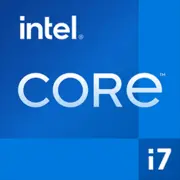Intel Core i7-11370H

Intel Core i7-11370H: Architecture, Performance, and Use Cases in 2025
Analysis of the relevance of the Tiger Lake processor for modern tasks
1. Architecture and Manufacturing Process: 10 nm SuperFin and Hybrid Capabilities
The Intel Core i7-11370H processor, released in 2021, remains popular in budget and mid-range laptops due to its balanced architecture.
- Cores and Threads: 4 cores and 8 threads (Hyper-Threading). Base clock speed — 3.3 GHz, maximum turbo frequency — 4.8 GHz. By 2025, 4 cores may seem modest, but the high clock speed compensates for this in single-threaded tasks.
- 10 nm SuperFin Process: An improved version of Intel's 10 nm technology with increased transistor density and energy efficiency. This has reduced heat generation and increased performance per watt.
- Integrated Graphics Iris Xe: 96 EUs (execution units), support for DirectX 12, 4K displays, and AV1 decoding. By 2025, this is sufficient for casual gaming (e.g., Fortnite on low settings) and graphics work in Adobe Photoshop.
Example: In laptops like the ASUS ZenBook 14 (2025, $800–900), the i7-11370H combines with 16 GB of RAM and a 512 GB SSD, providing quick app loading and smooth performance in Adobe Premiere Pro for 1080p video editing.
2. TDP 28 W: Balancing Performance and Battery Life
The TDP (Thermal Design Power) of 28 W indicates its suitability for thin ultrabooks and compact workstations.
- Thermal Package: The processor is optimized for devices with passive or compact active cooling. In turbo mode (up to 4.8 GHz), it consumes up to 40 W briefly, but under sustained load, stabilizes at 28–35 W.
- Energy Efficiency: Intel's Dynamic Tuning 2.0 and Speed Shift technologies adaptively adjust the frequency based on the load, which is critical for laptops with a battery capacity of 50–60 Wh.
Tip: When purchasing, check the cooling system. For instance, the Dell XPS 13 (2025, $950) with the i7-11370H does not overheat thanks to dual fans, while the cheaper Acer Swift 3 (2025, $700) may throttle under sustained rendering.
3. Performance: Real-World Use Cases
Office and Multimedia
- Running 20+ tabs in Chrome, Microsoft Teams, and Excel — no lag.
- 4K video in VLC or YouTube — GPU load does not exceed 40%.
Gaming
- CS2: 60–70 FPS at medium settings (720p).
- Genshin Impact: 40–45 FPS (low settings, 1080p).
Turbo Mode
Under transient loads (e.g., file archiving), the processor maintains 4.5–4.8 GHz for up to 30 seconds, then reduces the frequency to 3.8–4.0 GHz.
Example: For editing a 15-minute video in DaVinci Resolve, the i7-11370H takes about 25 minutes — reasonable for beginner videographers, but professionals might prefer a CPU with 6+ cores.
4. Use Cases: Who is the i7-11370H Suitable for in 2025?
- Students and Office Workers: For working with documents, Zoom conferences, and light creativity (Canva, Photoshop).
- Mobile Gamers: Only for casual gaming or streaming via cloud services (GeForce Now).
- Travelers: Ultrabooks weighing up to 1.3 kg with this CPU (e.g., Lenovo Yoga Slim 7, $850) offer 8–10 hours of battery life.
Limitations: Not suitable for 3D modeling in Blender, streaming encoding in OBS (1080p 60 FPS), or gaming at the level of Cyberpunk 2077.
5. Battery Life: How TDP Affects Usage Time
Under typical load (brightness 50%, Wi-Fi, browser):
- Laptops with a 60 Wh battery — up to 9 hours.
- In maximum performance mode — 2.5–3 hours.
Energy-saving Technologies:
- Intel Adaptix: Dynamic power management.
- Connected Standby: Background updates during sleep mode without battery drain.
Tip: Disable Turbo Boost in power settings to increase battery life by 15–20%.
6. Comparison with Competitors
- AMD Ryzen 5 5600U (Zen 3): Better in multi-threaded tasks (6 cores) but weaker in single-threaded performance (Geekbench 6 Single Core ~1500). Laptops with Ryzen 5 are often cheaper ($650–750).
- Apple M1: Higher battery life (up to 15 hours) and performance in applications optimized for macOS, but limited compatibility with Windows software.
- Intel Core i5-1240P (Alder Lake): 15–20% faster in multitasking due to hybrid architecture but more expensive ($1000+).
Conclusion: The i7-11370H in 2025 is a choice for those looking for an affordable Windows laptop with good single-threaded performance.
7. Pros and Cons
Strengths:
- High turbo frequency.
- Support for Thunderbolt 4 and Wi-Fi 6.
- Affordable laptop prices ($700–900).
Weaknesses:
- Only 4 cores — a limitation in multi-threaded scenarios.
- Iris Xe graphics lag behind AMD Radeon 680M and Apple M1 GPU.
8. Laptop Selection Recommendations
- Ultrabooks: Pay attention to weight (up to 1.5 kg) and screen quality (IPS, 100% sRGB). Example: HP Envy 13 (2025, $799).
- Budget Gaming Models: Look for versions with a discrete graphics card (NVIDIA MX550 or RTX 2050). Example: MSI Modern 15 (2025, $899).
- Workstations: Choose models with 32 GB of RAM and 1 TB SSD.
Important: Check for RAM and SSD upgrade slots — many ultrabooks have soldered memory.
9. Final Conclusion
The Intel Core i7-11370H in 2025 is an optimal option for:
- Users who value portability and speed in everyday tasks.
- Budget gamers willing to compromise on graphics settings.
- Those who don't want to overpay for the latest models but appreciate the stability of the Windows ecosystem.
Key Benefits: Price-performance ratio, battery life, support for modern interfaces (Thunderbolt 4), and sufficient power for most less demanding scenarios.
Basic
CPU Specifications
Memory Specifications
GPU Specifications
Miscellaneous
Benchmarks
Compared to Other CPU
Share in social media
Or Link To Us
<a href="https://cputronic.com/en/cpu/intel-core-i7-11370h" target="_blank">Intel Core i7-11370H</a>